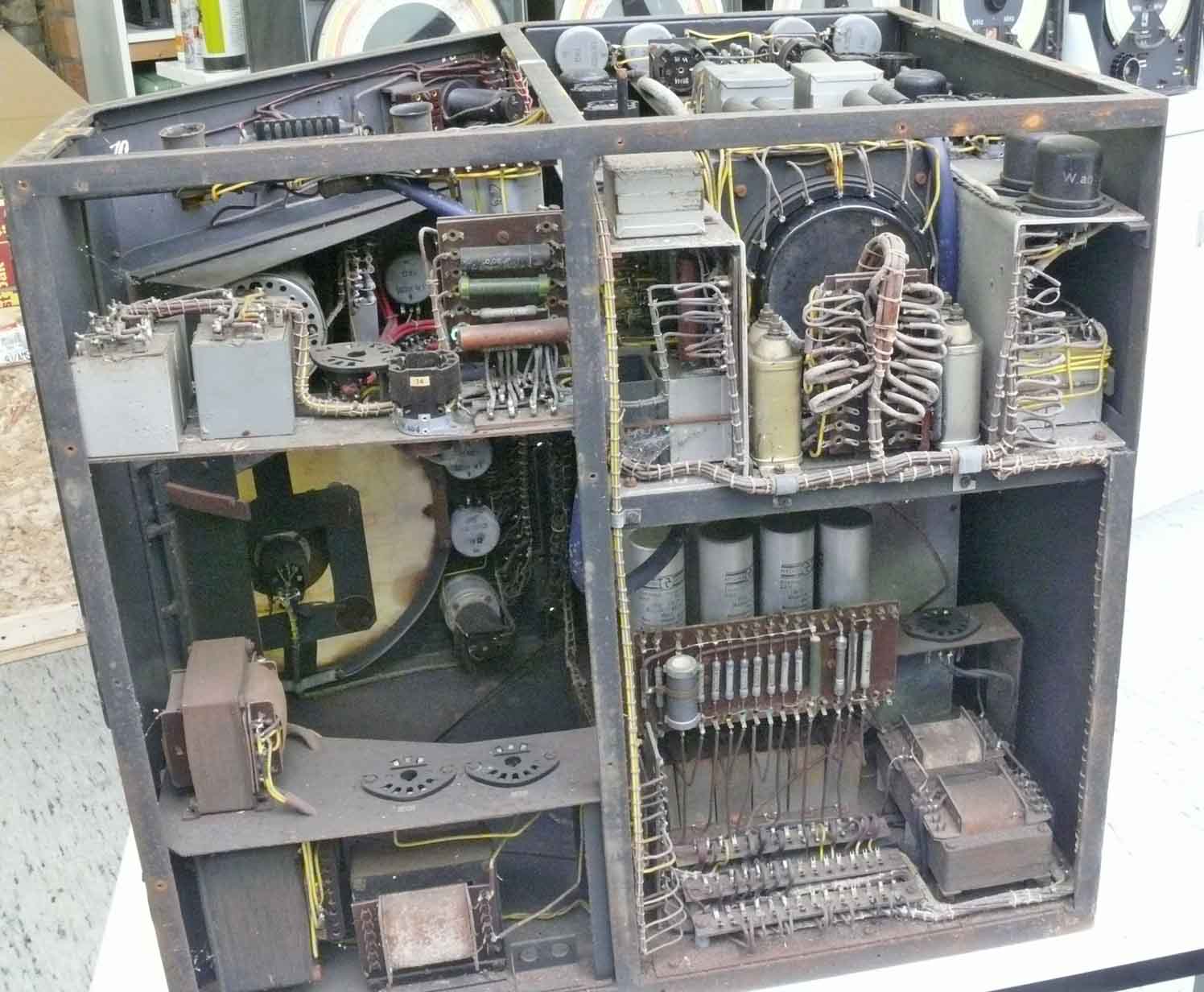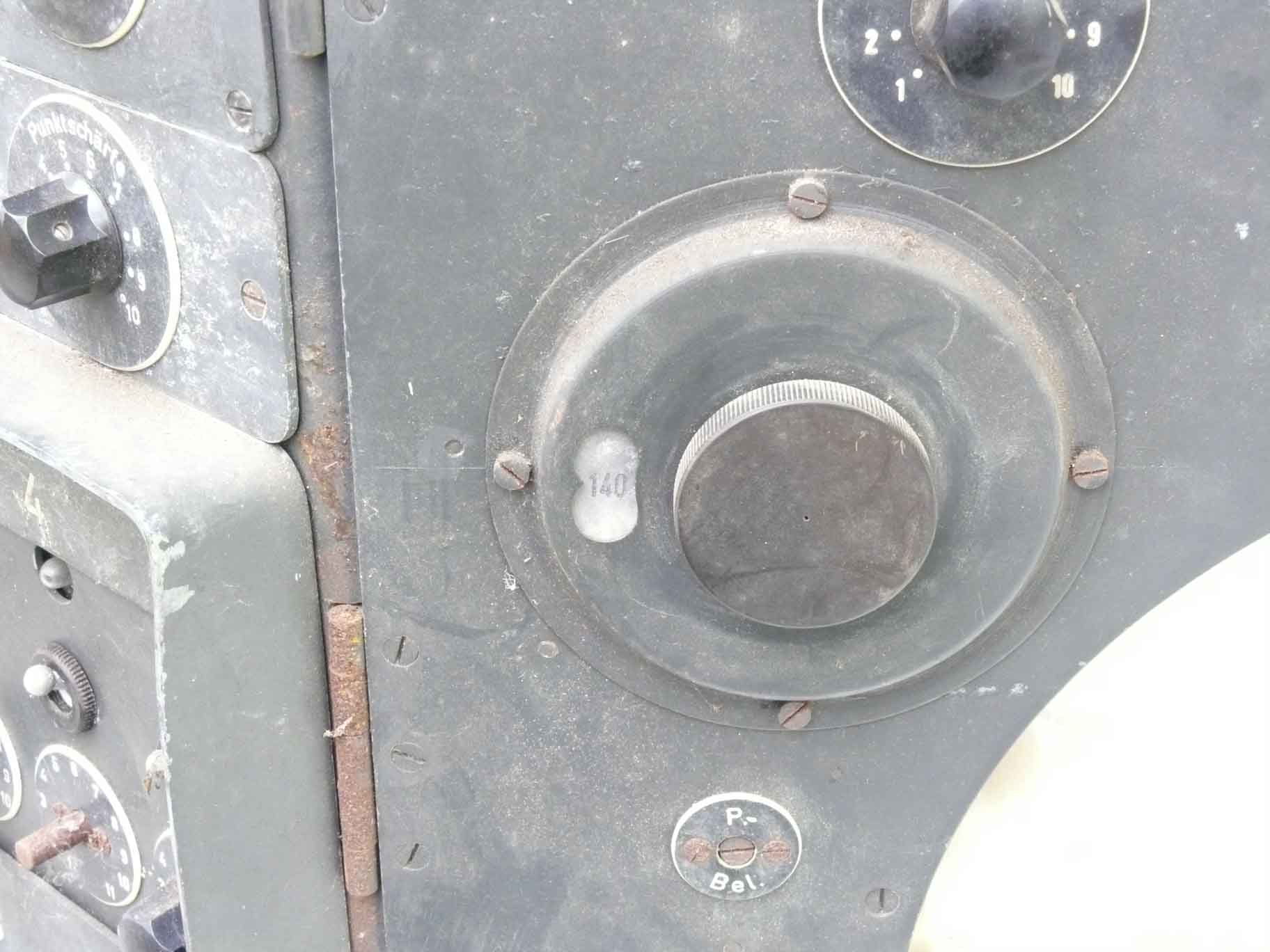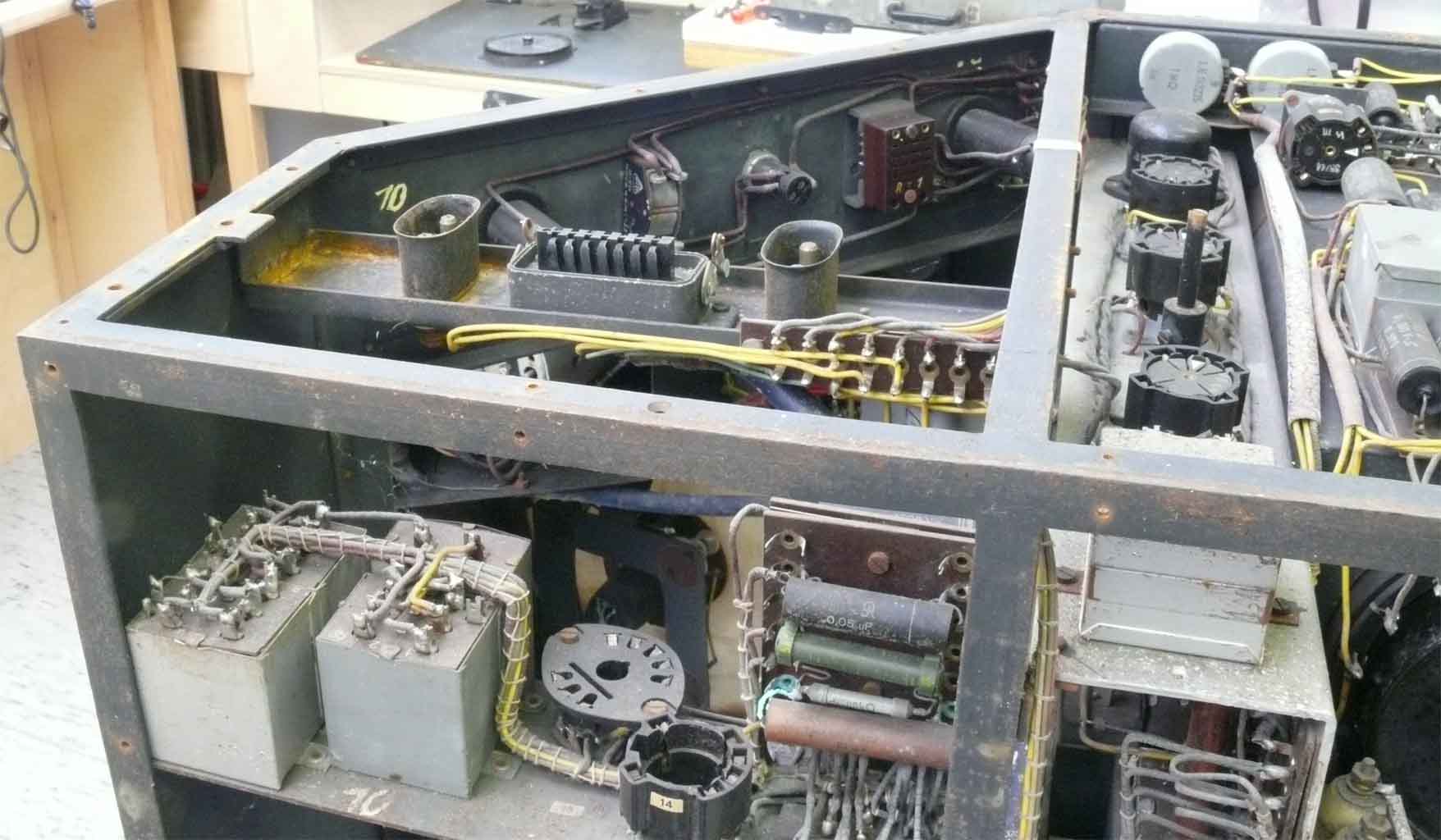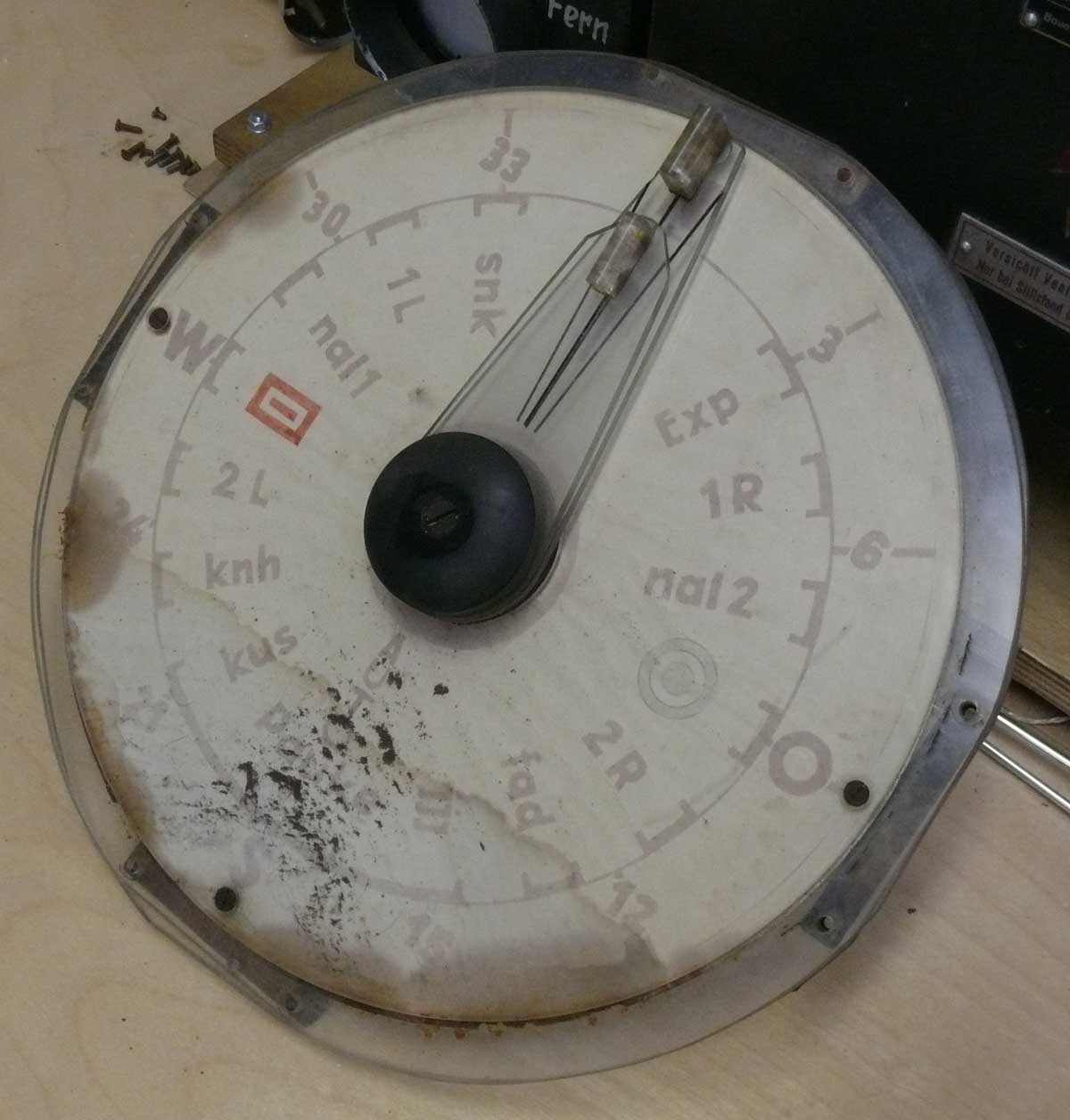
FuG136
codename:
Nachtfee
A survey
On 12 November 2011 a crate from the US arrived containing a long waited mysterious apparatus.
Status: 18 July 2012
New historical discoveries since 15 December 2011!
The Nachtfee survey has progressed so successfully, that a range of sub-pages have been created. Please notice the status of them very down this webpage
For me the story has started during early 2005. Someone sent me a link to an auction on EBay on which an unknown device was on sale. I looked at it myself and my bit was U$ 250. I also contacted some fellow collectors, but no one knew what it was. I luckily downloaded the accompanied photos.

Photo of the device on sale on EBay in 2005
In 2009 Phil Judkins and I were preparing for our CHESS presentation to be held for the DEHS Autumn Symposium at Shrivenham. Phil came twice to me in September and he brought along a bunch of paper copies of various PRO/NA files. Along it was the TRE report on the See-Elefant radar site at RØMØ, but also Radar News 19 the translation of the German radar magazine called Funkmessnachrichtem 19 date of issue 25 February 1945!
On its last page my breathing virtually stopped.

When we compare the above illustrations it is clear that both are identical devices
Our next move was putting a query about this mysterious apparatus on the web. This happened just two years ago. It took about two and a half weeks and I received a message "I have it". From now on rather tough negotiations took place. However, it is now in our collection.
What is it? It certainly is not radar in the direct sense. It is, however, a desperate move trying to escape from the intensive jamming of their communications and other means. It is a means to transfer particular commands (Orders) towards their night fighter aircraft. According Radar News 19:
“Nachtfee” (FuG 136).
Airborne attachment to the “Erstling” receiver (weight 12 kg.), ground attachment to the “Egon” transmitter, needing two operators. Transmission of 16 visual signals which are read off on a cathode ray tube in the aircraft. The apparatus is only suitable for two-seater aircraft, as a continuous intensive watch has to be kept on the visual indicator. Transmission of commands is only possible to an aircraft which flies in the lobe of the ground apparatus [EGON-B station, AOB]. Owing to interruptions in production, it is not possible to give a date for delivery.
The last sentence: Owing to interruptions in production, it is not possible to give a date for delivery. Please remember, that this magazine was issued on 25 February 1945! Thus at a time when Germany was falling into pieces (deteriorating).
One of the new aims, is to create a paper together with Hans Jucker. He will take care of technical aspects of the German IFF FuG 25a system (this contribution is only explaining the principles of German IFF, and not particularly in conjunction with EGON-B, in his usual technical way. However, the FuG25a might have (only) been adapted such that the EGON-B (receiver) signals were also fed onto the Nachtfee repeater CRT in the aircraft cabin). My contribution is to discover some of the Nachtfee's hidden technologies or call it secrets. Our mutual aim is bringing to daylight as much as possible from this system. We must, however, be aware (clear), that we only can lift some of the aspects, as the system was never coming into military service. I also realised some weeks ago, that the 'fig. 6' drawing hardly is of German origin, as the Germans themselves never would have drawn it in this way. Tricky for historians - is that they nowhere mention this aspect! Simply, because when Germans place pointers in a drawing their text is also referring to it, which in the Radar News 19 translations isn't the case. According the PRO/NA (Kew) index the original German Funkmessnachrichten 19 should exist, but it cannot be found. The mystery will thus remain.
After I have invited him to participate in this project, he did sent me a short e-mail comment (7-10-2011):
For me very surprising what the German designer actually have planned to integrate into this
system. For my understanding beside of vulnerability for active jamming was the limited duty
cycle caused by the power supply a serious problem for upgrade programs.
Please consider also our Survey page(s), which are dealing with unravelling the Nachtfee secrets, accessible at the end of this webpage

The Nachtfee apparatus, as it had just arrived from the US. The controlling or Command (Order) panel being moved such that it makes a more or less in line with the channel selectors. Although, I have not yet an idea what the 10 channels had been meant for
Please notice, that the left-hand side CRT is from our stock!
The first impression is, that the lower scale part is a bit more deteriorated, compared to the previous photo taken about 2005

The controlling panel moved such that it is in line with the shape of the chassis (pushed inside its housing again)
The two CRTs were missing. The left one clearly has to be the dual beam as was used in Freya and related radar systems. Although, apparently the front mounting-window is missing, so that the quite heavy CRT is owing to gravity tending downwards. The CRT mounting-hole above the controlling window was unknown. I firstly though that it might be meant for a LB1/LB8, which it apparently is not. The handle (pointing to the right) is rotating the cylinder inside the CRT housing. It should thus being a magnetically deflected CRT, like the LB2. This is also in line with the fact, that the two contact pins of the CRT are also the only two being wired on the base-mounding-plate. We have to wait for a special "LB2" which is having an aluminium circular mounting/puller-cylinder.

The rear cover-plate being removed
On the left we see two rectifier valve sockets (11 series). In the upper-right section we notice the socket/base of the double beam CRT.

Two channels of the dual-beam CRTs
I do not know yet, whether it is deflection- or video like channels. The blue coaxial cable is indicating that its signal content is of a higher frequency spectrum, such as radar like video (maybe from the Gemse RX). The four potentiometers near the front panel are meant for left-right and up-down movement of the dual base line circles (circular deflections).

"Impuls-Amplitude" (centre upper control) might mean signal amplitude at the CRT screen
The numbers 1 - 10 are related to 10 channels, which could be selected at will.

The scale number 140 is, to my understanding coupled with a servo motor (Drehfeldübertrager).

The command panel. The long pointer is likely used for compass like commandos. The smaller pointer is pointing at instructions like 2 R or nal 2
I guess that the control "Phase" is controlling some of the signals painted at the LB2 CRT (not visible above the controlling window)

The device in the centre of the square is also servo drive (master)
The rectangular frame is at its corners carrying sockets for small lamps for the scale illumination

In between the two 220 V mains plugs is the interface connector; of the well known "List-Stecker" type
Does this imply that the existence of two times number '10', that it concerns serial number 10? It also might indicate, that it is a kind of running number or that both parts belong to a module 10 series. Bearing in mind the Berlin (FuG224 radar apparatus, where it is likely that each separate module carried a running serial number, such that the next similar device getting a serial number that is available at present (thus not 10, 11, 12 ...). Numbers might even jump equal to the total amount of modules being used in a single Berlin apparatus. I guess, that this was being practised on a wide scale, as is also the case in our Würzburg apparatus.

Number 478 is hardly in concert with the maximum number of Urechse according Hoffmann-Heyden to be ever produced (125). And, given the extreme rarity of this device, we may even assume that it had been produced in a much lower quantity

The front panel of the 10 channel setting being removed and a module is randomly pulled out

6. stands, most likely, for channel 6 as this module has been pulled out. NF 13 might indicate low frequency 13?? (NF = Niederfrequenz?)
The switch might control the HT connection, but it is also switching a signal-lamp, indicating which channel is active at present.

Viewing at the 6 contact pins
All 10 modules are being plugged into a mutual module, which function I don't know yet.
We face a serious problem, as nearly all wires are having equal (yellow) colour. This makes it not easy finding out where a particular cable is going to. (interconnected with).
It may be regarded being the only sample that has survived, and hardly documentation is somewhere accessible. Maybe in the Library of Congress, though, who is willing to support us with approaching this centre? From Holland it is hardly possible, as likely one have to visit this institution several times.
Calling for an American citizen, who very kindly is supporting us with tracing any form of information. Nachtfee was shipped (as being captured equipment enemy) to the United States about 1945 and likely someone has done some investigations on it. According its previous owner, he obtained it from someone in the vicinity of Dayton (Ohio).
![]()
Please type in what you read
The next step undertaken is
Surveying what Nachtfee technically is about
As to limit the loading of this introduction page we have to introduce particular survey-pages
On 14 December 2011
I discovered and correlated a most interesting British wartime investigation report:
Air Scientific Intelligence Report No. 101
German Radar Development
Actually it is originating from Dr. R.V. Jones!
Also known as an A.D.I. Report

The header of A.D.I. Report 101
For this occasion I have selected only the header with the first beneficiary Churchill's War Cabinet, addressed to Churchill's technical advisor Lord Cherwell (Prof. Lindemann)

Skipping some pages and starting with paragraph 11

The full content of page 6
Please notice also 12.2 where he tells that the British were surprised by the discovery of complete British Mark II GEE equipment in a Ju 188 of I/K.G.66 (Pathfinder group which crashed on 24.2.44. He also points: While GEE has been used during the recent London raids, it appears that I/K.G.66 were relying primarily on the FuGe 25A method (thus EGON-B with Nachtfee, AOB) and that the GEE aircraft were only backing up the flares released by the others. The GEE method was therefore probably a trial ...

Part of the content of page 7
Paragraph 12.5 is for us most interesting
Confirmation has come from prisoners from I/K.G.66, who say that they have to fly straight and level from some distance through the A.A. defences, and receive course corrections from the ground station (EGON-B in combination with Nachtfee, AOB), which give them the order to drop flares, and claims to tell them (when they arrive home) where they released their flares to within 300 metres. The orders are transmitted by R/T either on the FuGe 16 (FuG 16, AOB), or on the FuGe 10 (FuG 10, AOB), with R/T attachment; from the language used it seems likely that the bombing method was evolved by a controller with experience of Freya-controlled fighting (the bomb dropping order, for example, is "Pauke, Pauke", which is the standard for nightfighter order to attack).
This may provide a clue to the tactical method used. The Freya-AN control of fighters consists of turning the split beam on to the target, and telling from the size of the right or left responses of the fighter's echo whether he is too much to the right or or left in his approach. The controller then orders "Rolf" or "Lisa" (10° Right or Left) (please notice the next photo of the Nachtfee order "Compass", AOB) as required, and it is significant that similar instructions are used in the FuGe 25A (FuG 25a, AOB) bombing. The system as at present practised is probably therefore to take a Freya with split (Freya A/N, on our Nachtfee apparatus is a strange switch "Freya-Polwender" which might be brought in connection with switching over to split-beam-operations, AOB), sight it over the target, and fly the bomber down the line of sight, giving course corrections as required. When the correct range is reached, the controller orders the bomber to drop his flares (Pauke, AOB). The FuGe 25A is only essential to the system at long ranges or to identify the bomber. The beam of the Freya is so wide that even when the bomber is off course considerably, he is still within the field of view; there would be no need to swing the Freya once it is aligned. This method is much more probable at present than the dual range cut system of 'Oboe' proper, and it implies that each of the three Freya transmissions heard (EGON-B? AOB) could handle aircraft separately. The accuracy is unlikely to be much better than a mile except with very well trained crews.

Our Nachtfee "order compass" which just have been removed from the Nachtfee main chassis. As we would like to look whether it might be possible to stop the fungus like phenomenon which is in between the Perspex (Plexiglas) front disk and the semi-transparent paper sheet
Please notice the scale text symbols '1 L' and '1 R' as well as '2 L' and '2 R'. Likewise is even to day the usual NATO spelling: A = Alfa, B = Bravo etc.; the Germans used A = Anton and B = Berta. Rolf and Lisa may have been used in the communication between the pilot and the Nachtfee operator in the rear seat of the aircraft, he being also R/T- and radar operator (as well as rear gunner). He should have been the person to monitor the CRT screen where the Nachtfee commands where displayed upon. The meaning of the other abbreviations is for us a mystery, as their meaning might be camouflaged. Who knows what, for example, 'jjj' may have stood for?
We may assume, that R.V. Jones was by then (mid March 1944) not yet fully informed by the exact way Nachtfee was commenced. It is even not unlikely, that after the Germans cancelled further 'baby Blitz operations' on London, that Nachtfee was never operationally used against Brittan. When this is true, he couldn't outline further information on the EGON-B system. In contrast, he certainly obtained manifold intelligence on EGON-A their standard controlling system.
From Jones's report, we also can learn that the Allies may have been very much surprised by the operational exploitation of IFF in general. This may be the background of his commend (paragraph 11.1 at page 5): Recognition is traditionally a difficult matter: the Germans have surpassed tradition.
What knew Fritz Trenkle about Nachtfee?
In his booklet titled "Die deutschen Funkführungsverfahren bis 1945" he describes:
Kommando-Übertragungszusätze (Bladwijzer56)
Inzwischen wurden auf deutscher Seite natürlich Versuche zur Entstörung der allein anfälligen Nachrichtenverbindung der Kampfflugzeuge unternommen durch Einführung von sog. Kommando-Übertragungsgeräten. Die primitivste Art stellte das Verfahren "Nachtlicht"(ohne FuG-Nummer) dar, das man im Frühjahr bei Angriffen auf London erprobte. Hierbei verwendete man das Kenngerät FuG 25a, die immer dann aufleuchtete, wenn das Gerät angestrahlt = abgefragt wurde. Man stellte an der Kanalküste ein auf 117,5 MHz umgestelltes "Freya"-Gerät auf, das bei Bedarf durch Morsetastung seines Funkmeßsenders die Kommandos zu den Flugzeugen übermittelte. Als Bordgerät dürfte entsprechend der verwendete frequenz das Kenngerät FuG 25b "Erstling-grün" verwendet worden sein. [101]*
* His curious source [101] is not been traced yet, it might, however, be available somewhere in the US. So far, no one else have seen it. As Trenkle is mainly referring to this reference, I regard it being the "Opus magnum" of all references.
Im Juli 1943 entwickelde die E-Stelle Rechlin (T. v. Hauteville)(Bladwijzer4) zusammen mit der Firma Fitze im Juli 1943 den Kommando-Übertragungszusatz FuG 136 "Nachtfee" zum Kenngerät FuG 25a "Erstling". Man erprobte den in fünf Mustern gebauten Zusatz# in Flugzeugen des K.G. 66 im Frühjahr 1944 zusammmen mit dem EGON-Kampf-Verfahren (EGON-B, AOB) bei den Angriffen auf London und beim Minenlegen der Scheldemündung (why should they have done this in the early months of 1944, as they then still ruled freely over that part of Europe. My guess, that what he mentioned jumps ahead in time and was accomplished after the Germans lost control over that area; thus after say September/October 1944, AOB). Als Anzeige diente eine Braunsche Röhre mit Kreisablenkung. Innerhalb und außerhalb der Kreiszeitlinie waren je acht Felder vorgesehen†, von denen die inneren beim ersten Durchlauf, die äußeren erst beim zweiten Durchlauf galten.* Die Anzeigeimpulse wurden offensichtlich durch in ihre Phase verschiebbare Zusatzimpulse des "Freya"-Senders erzeugt+ . Da dieses Gerät relativ leicht störbar war und eine dauerende Beobachtung durch ein Besatzungsmitglied erforderte, kam es nicht zur Einführung [101].
# According Trenkle 5 display units had been build for application in aircraft. A bit confusing is whether this number is also pointing at the Nachtfee 'order' or 'command' terminals manufactured.
† Please consider the previous 'order compass' photo, where it is hardly understandable what he actually is meaning.
* My guess, is that the dual-beam CRT-screen on the left hand-side of the Nachtfee front panel is being described.
+ It is, however, debatable whether the phase keying was actually done in the EGON-transmitter (Freya-Sender), or that the complete video like signal came integrally out of the Nachtfee apparatus. As the (operator) was the one who could check whether an 'order' is in accordance with the (video) signal transferred towards the EGON-B transmitter. That he states this might have been caused by the fact that he never have seen a Nachtfee apparatus himself. His source might have been the ominous [101]; and probably eyewitness recordings (aural history).
Furthermore curious is the fact, that our Nachtfee apparatus carries for the RV12P2000 used acceptance dates (Abnahmestempel) up to week 44 in 1944. Which points, that our Nachtfee apparatus was manufactured, or at least accepted, in very late 1944. When we bear in mind, that 'July 1943' is referred to, the application of such inferior tar-roll-capacitors was most unlikely in 1943. When we think of production about mid 1944, when their supplies became very over-stressed, they might not have had access to professional (standard) components.
Furthermore in Trenkle's: "Die deutschen Funk-Navigations- und Funk-Führungsverfahren bis 1945, he points on "Nachtfee":(Bladwijzer8)
.... Die E-Stelle-Rechlin (T. v. Hautville) entwickelte zusammen mit der Firma Fitze im Juli 1943 den Kommando-Übertragungszusatz FuG 136 >>Nachtfee<< zum Kenngerät FuG 25a >>Erstling<<, wobei erster in 5 Mustern* erstellt und beim K.G. 66 im Frühjahr 1944 zusammen mit dem Egon-Kampf-Verfahren bei Angriffen auf London und beim Minenlegen der Scheldemündung (please consider my previous doubts, AOB) erpropt wurde. Als Anzeige diente eine Braunsche Röhre mit Kreisablenkung und stationärer Auslenkung in der 0°-Position (ähnlich dem Sichtgerät FuG 214 >>Lichtenstein BC/R<<). Bei Kommandoabgabe löste sich eine 2. Auslenkung aus der ersten und wanderte innerhalb von 2 Sekunden auf der Kreislinie durch die dort eingezeigneten und mit Kommandos beschrifteten Felder bis zum gültigen Komandofeld. Innerhalb und außhalb der Kreiszeitlinie waren je 8 Felder vorgesehen, von denen die inneren beim ersten Durchlauf, die äußeren erst beim 2. Durchlauf galten (nach Vollendung eines Vollkreises). Die Anzeigeimpulse wurden offensichtlich durch in ihre Phase verschiebbare Zusatzimpulse des >>Freya<<-Senders erzeugt+. Da diese Anzeige relativ leicht störbar war und eine dauerende Beobachtung durch ein Besatzungsmitglied erforderte, kam es nicht zur Einführung.
+ Trenkle's used the word – ‘offensichtlich’- which might imply that he thinks, but does not know it exactly. I strongly believe, noticing that our Nachtfee apparatus has 2 CRTs of which one is a dual-beam type (not particularly designed for circular screen presentation and a LB2 which is a typical circular presentation CRT; which was also used in the Lichtenstein b/c airborne radars.
On 16 July 2012
Is added details found in: Die deutsche Luftfahrt Flugerprobungsstellen bis 1945 on page 325 - E4 Dipl.-ing. v. Hauteville and Fl.-Obering. v Hauteville. I also reconsidered the Blohm & Voss project 194, where on page 1 and 2: Sachbearbeiter (referent) is Fl. Obering. Beck, for documentation F.-Obering. Bracke (both in Rechlin)


This is very interesting information, although, we cannot yet exploring it. But it might give us a different approach
Flieger-O-Ing Beck, Rechlin. Unterlagen soll Fl. O-Ing Bracke baldigst Übersenden
Also historically relevant in this retrospect

December 1943 the EGON Procedure was practised at Rechlin and later on from Montdidier (France, AOB)
Also interesting, although, the name may have been spelled not entirely correctly; Stabsingenieur Benes (Fl-Stabsing., AOB) is named in respect to Nachtfee. The 'attachment' may have been FuG136, thus the aircraft display system

The way Nachtfee should have been operated
This drawing is fully in accordance with R.V. Jones's assessments in his A.D.I. Report 101
Please notice the new contribution On 20 February 2012 on our Nachtfee evaluation and conclusion page.
On the 1 of March 2012
I received a message from Jørgen Fastner from Norway, in which he is contributing with just received information
Quoting (Bladwijzer5):
The handwritten papers are about a "Besprechung am 16.5.44 über P 194".
'Anwesend: die Herren Schukart?, Becher, Fl-Stabsing. Bassinger Fl.-Obering. Bracke und Wichel
I. Ausführung als Nachtjäger hat folgende FT-Anlagen:
1. FuG10P
2. FuBL2F
3. FuG15Y
4. FuG25a
5. FuG136
6. FuG101a
7. FuG220
8. FuG217
9. FuG227
ev. 10. FuG350Z
Zu 1. ..
.
Zu5. Kommandogerät, aufschaltbar auf Sende-Empfangsgerät FuG25a. Das FuG136 is fernbedient. Das Sichtgerät bekommt der Flugzeugführer. Sachbearbeiter ist Fl.-Ober-Ing. Beck, Rechlin. Unterlagen will Fl.-O.Ing. Brache baldigst übersenden.
P 194 was a Blohm & Voss aircraft that was planned but never build I think. The papers are marked "Blohm & Voss Flugzeugbau Hamburg", and are about the FT-Anlagen in P 194 als Nachtjäger, Schlachtflugzeug und Zerstörer.
For us, the reference “Das FuG 136 ist fernbedient” is of some relevance, as this aspect is dealt with in the Nachtfee-Inbetriebnahme & (evaluation and conclusion) as well as Nachtfee-FuG25a pages.
Please consider also the additional information added on 5 March onto the Nachtfee-FuG25a webpage (Bladwijzer11)
Please don't forget to use the handsome: Nachtfee Chronology page
And, the PowerPoint progress page (converted into PDF)
To be continued in due course
Please notice also our recent new discoveries: Nachtfee new findings (Status: 12 May 2012)
Survey page 1 & 2 (date 21 and 23 November 2011)
Survey page 3 (started on 30 November 2011) (status: 21 December 2011)
Survey page 3a superseding page 3a (status: 26 December 2011)
MLK-lab. survey (started on 2/5 December 2011) (status: 13 December 2011)
Please consider also our Nachtfee discussion page (status 5 January 2012)
Nachtfee Inbetriebnahme Making the Nachtfee apparatus successfully working again. (status: 5 March 2012)
Nachtfee evaluation and conclusion (status: 1 March 2012)
Nachtfee FuG25a project - investigating how the Nachtfee data was conveyed towards the aircraft display (status: 5 March 2012)
Simulating the Nachtfee signal transfer via the FuG25a IFF system (status 12 March 2012)
Please notice also our: query page
By Arthur O. Bauer
Please consider also our addional page on the implication of Freya-EGON and Nachtfee
Please go back to, or proceed with: Handbooks papers and product information